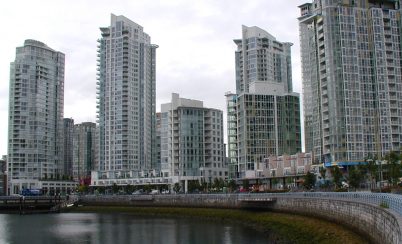PT reader Timothy Thomas writes in:
Lisa Rochon hits the nail on its monotonous little head. Finally, after five years, I understand the paradox: how Vancouver can be progressive in livability but so maddeningly conservative in design.
If the Olympic Village architecture leaves another disappointing legacy, maybe they can install an explanatory plaque: “They didn’t want it good. They wanted it Tuesday.”
Rochon’s Globe and Mail piece – “Time to build outside the box” – critiques the architectural scene in Vancouver, now that previous planner Larry Beasley is off to Abu Dhabi.
Over the past decade, Vancouver has developed a culture of urban rules rather than a culture of great design. There are rules for just about any move an architect might want to make….
And now that Beasley is gone, architects speak up:
“It’s a huge challenge for the new director,” says Bing Thom, a prominent Vancouver architect. “We’ve become a victim of our own success. There’s smugness and fear of change. The planning department knows what it wants, the architect knows what the planning department wants and nobody dares to rock the boat. Everybody is in bed together. The podium-tower formula keeps getting stamped out in Vancouver, because everybody knows that will get quick approval.”
“The Beasley regime was so formulaic,” charges James Cheng, another of Vancouver’s major architects who designed the 60-storey Shangri-La luxury hotel and residence currently under construction on West Georgia Street in the city’s downtown.
Hmmm. The supposition seems to be that if the architects were freed of the Planning Department’s constraints, great, iconic architecture would spontaneously appear.
Sorry, don’t buy it. Market-constrained design is inherently conservative. Once the developers discern the minimum acceptable standards, they set the ceiling, not the floor.
I well remember an informal meeting I had in James Cheng’s office with one of the City’ Hall development-permit architects. They were responding to a concern I had, after seeing the model for Quayside – the Concord Pacific complex that now lines Marinaside Crescent, between Davie Street and the Cambie Bridge – that it was all too much the same. How about at least a little variation in colour?

Both of them assured me that, though it was subtle, it would fit well into the larger palate that was planned for the megaproject. I didn’t get any sense that the City was forcing a reluctant developer into a straight-jacket.
As a Councillor, there really wasn’t much I could do other than express my concern. Other Councillors didn’t like getting involved in design decisions – the job, they felt, of the professionals. And indeed, the development process in Vancouver keeps politicians out of the approval process once Council decisions have been made on zoning and general policy. It’s one of the reasons the quality of urban design is high: no deals are done to dumb-down projects; negotiations are done at the staff level, insulated from the politics.
Yes, there’s a need for more ‘iconic’ foreground buildings in Vancouver. But too often the suggestion is made that by negating, amending or ignoring some general policy – like height limits or view-corridor requirements – we would get brilliant architecture as a result. I just don’t think the record, the experience of other cities or common sense gives a guarantee of that.













Okay Gordon, you’ve got the direct experience to refute Rochon’s critique. So why don’t we have more visually creative architecture? If it’s the fault of benighted developers, can the Design Panel stimulate them to commission better designs? Why is it that developers in many other major cities on the continent (even dowdy Kansas City!) are commissioning work of far greater esthetic quality, and still make money? Why can’t we be more open to the work of architects from all over the world? Is it accurate to think that for all the lip service of Vancouver as being a “world city,” our developers still think like a small town, uncomfortable with strangers, relying on the same people and the same look over and over again? Remember the lines from G.B. Shaw: “Some look at things that are, and ask ‘why?’. Let’s dream of things that never were and ask ‘why not?’ “
Rochon’s article doesn’t really say anything that we didn’t already know. I do agree that the UDP prevents really, really bad projects.
The built form in Downtown South may be a consequence of the restrictive zoning bylaws applicable to Downtown South in conmbination with the Design Panel review. i.e. the tower separation, the floorplate dimensions/area, balconies, etc. don’t leave much wiggle room.
The UDP then requires a warm colour pallette and clear glass.
And of course, the same developers are building what they know best over and over again.
One friend of mine who is a structural engineer said that the cascading tower at Bayshore was incredibly difficult (expensive) to build because each floor was different and used different concrete forms than the floor below.
Have you noticed that the industry has moved from having different floorplans on lower floors (small suites) versus upper floors (big suites) to floorplans that are the same for the full height of the tower? That’s driven by cost efficiencies.